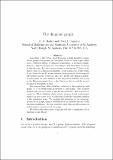Files in this item
The diagonal graph
Item metadata
| dc.contributor.author | Bailey, R. A. | |
| dc.contributor.author | Cameron, Peter J. | |
| dc.date.accessioned | 2021-12-23T11:30:04Z | |
| dc.date.available | 2021-12-23T11:30:04Z | |
| dc.date.issued | 2021-12-21 | |
| dc.identifier | 274635532 | |
| dc.identifier | 1872ac81-870d-4f65-a151-91cf4b200738 | |
| dc.identifier | 000735888500012 | |
| dc.identifier | 85129992896 | |
| dc.identifier.citation | Bailey , R A & Cameron , P J 2021 , ' The diagonal graph ' , Journal of the Ramanujan Mathematical Society , vol. 36 , no. 4 , pp. 353-361 . | en |
| dc.identifier.other | ORCID: /0000-0003-3130-9505/work/105318437 | |
| dc.identifier.other | ORCID: /0000-0002-8990-2099/work/105318439 | |
| dc.identifier.uri | https://hdl.handle.net/10023/24569 | |
| dc.description.abstract | According to the O'Nan--Scott Theorem, a finite primitive permutation group either preserves a structure of one of three types (affine space, Cartesian lattice, or diagonal semilattice), or is almost simple. However, diagonal groups are a much larger class than those occurring in this theorem. For any positive integer m and group G (finite or infinite), there is a diagonal semilattice, a sub-semilattice of the lattice of partitions of a set Ω, whose automorphism group is the corresponding diagonal group. Moreover, there is a graph (the diagonal graph), bearing much the same relation to the diagonal semilattice and group as the Hamming graph does to the Cartesian lattice and the wreath product of symmetric groups. Our purpose here, after a brief introduction to this semilattice and graph, is to establish some properties of this graph. The diagonal graph ΓD(G,m) is a Cayley graph for the group Gm, and so is vertex-transitive. We establish its clique number in general and its chromatic number in most cases, with a conjecture about the chromatic number in the remaining cases. We compute the spectrum of the adjacency matrix of the graph, using a calculation of the Möbius function of the diagonal semilattice. We also compute some other graph parameters and symmetry properties of the graph. We believe that this family of graphs will play a significant role in algebraic graph theory. | |
| dc.format.extent | 263958 | |
| dc.language.iso | eng | |
| dc.relation.ispartof | Journal of the Ramanujan Mathematical Society | en |
| dc.subject | QA Mathematics | en |
| dc.subject | T-NDAS | en |
| dc.subject.lcc | QA | en |
| dc.title | The diagonal graph | en |
| dc.type | Journal article | en |
| dc.contributor.institution | University of St Andrews. Pure Mathematics | en |
| dc.contributor.institution | University of St Andrews. Centre for Interdisciplinary Research in Computational Algebra | en |
| dc.contributor.institution | University of St Andrews. Statistics | en |
| dc.description.status | Peer reviewed | en |
| dc.date.embargoedUntil | 2021-12-21 | |
| dc.identifier.url | http://jrms.ramanujanmathsociety.org/articles_in_press.html | en |
| dc.identifier.url | https://arxiv.org/abs/2101.02451 | en |
This item appears in the following Collection(s)
Items in the St Andrews Research Repository are protected by copyright, with all rights reserved, unless otherwise indicated.

